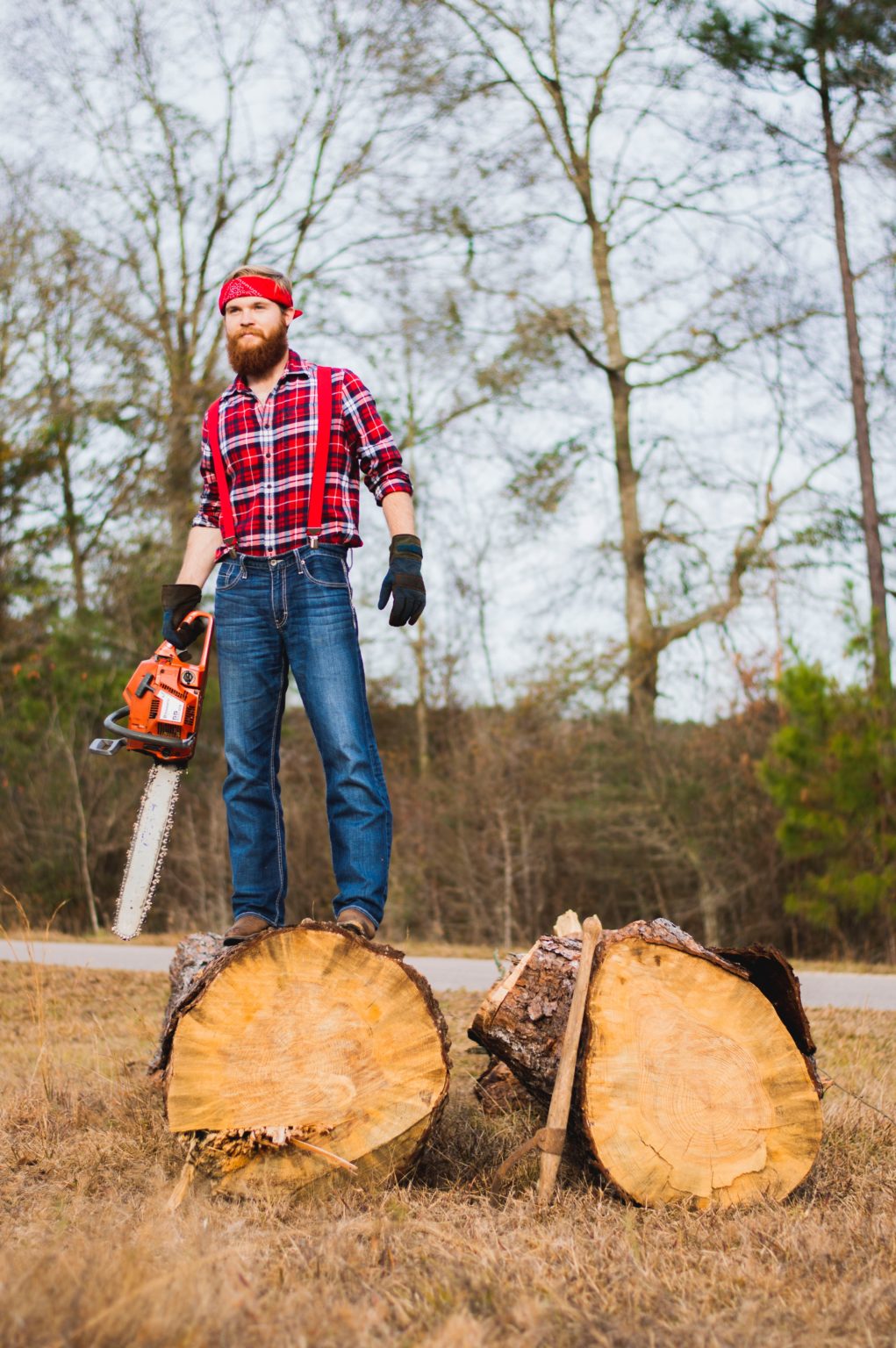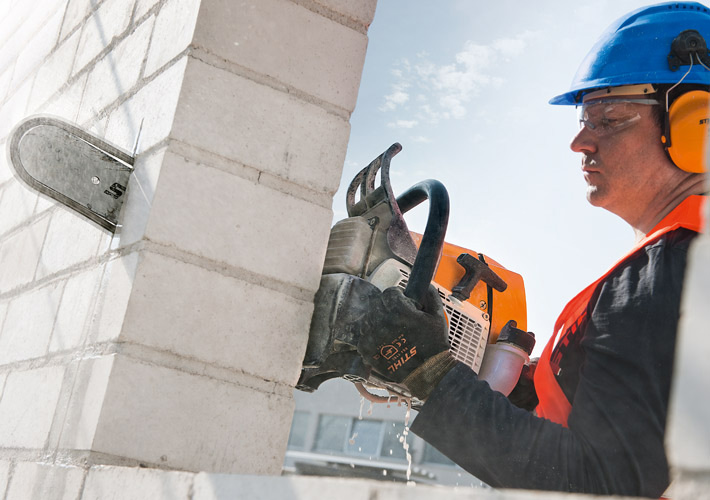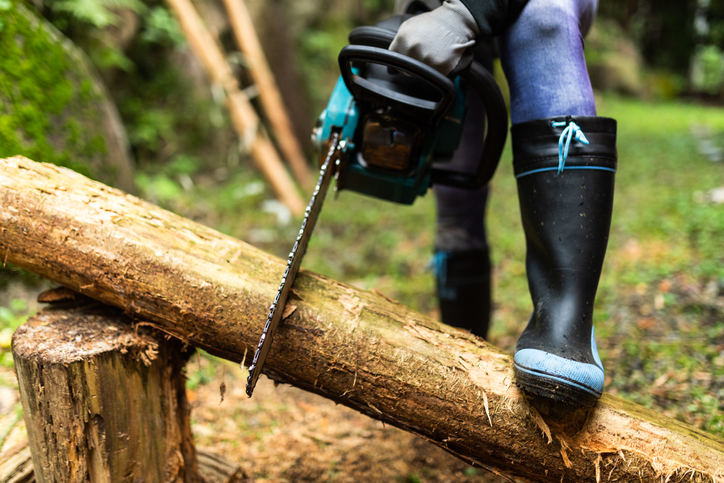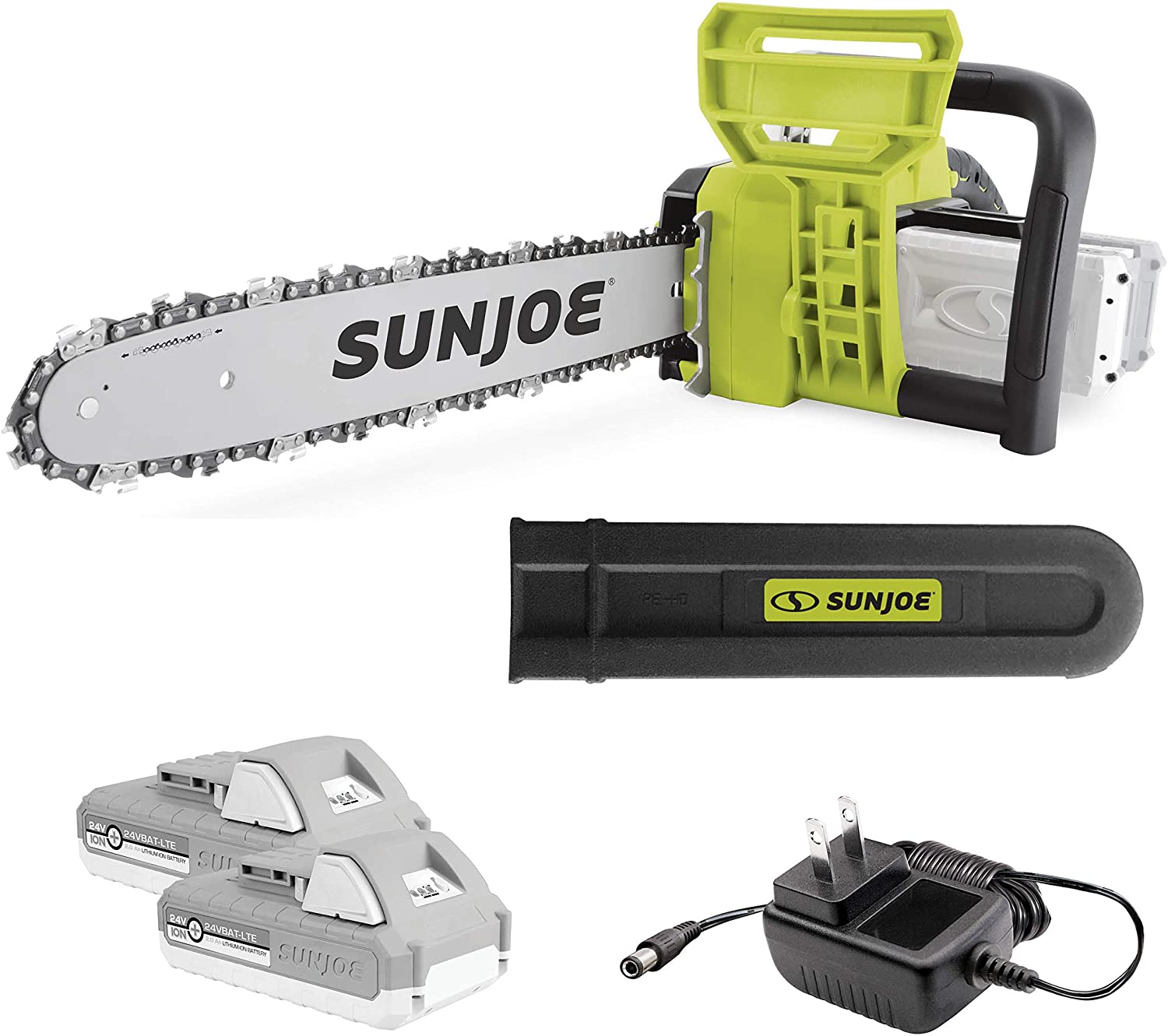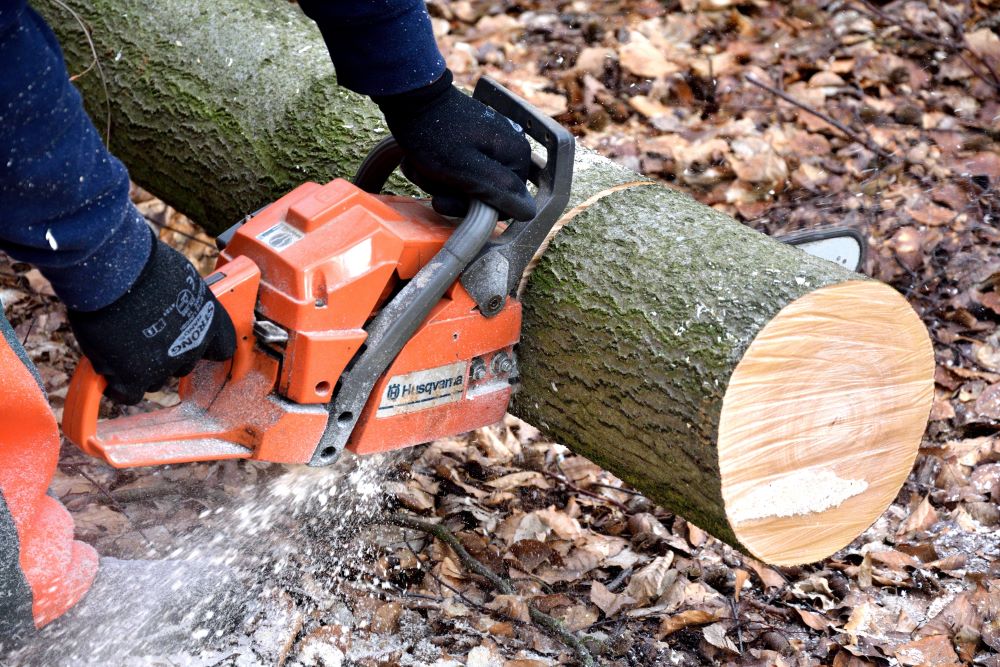Chainsaws can cut through much more than just wood. They can cut through plastics as well as various types of metal tubing and even some concrete. As far as wood materials go, chainsaws are commonly used to cut through oak, almond, ash, hard maple, and various types of hickory and birch. But when a chainsaw chain gets dull, it makes it difficult to cut through any kind of material. Keep reading to learn more about chainsaws, including signs of a dull chainsaw chain and how to sharpen it.
Benefits of Using a Chainsaw Chain
A lot of tools these days are unnecessarily complicated due to too many buttons and options. You can easily use a chainsaw one by simply pressing a single button. Some even turn on and are ready for use with just the turn of a knob.
Whether you opt for a gas-powered chainsaw or an electric-powered one, you’ll enjoy the simplicity integrated into its ease of use. Switching out the fuel on gas-powered chainsaws is as simple as filling your car’s tank up with gas, and charging an electric version is as simple as plugging in and charging your smartphone. Chainsaws are simple to handle once you understand how they operate and have some experience with them. You still need to exercise caution and wear the appropriate safety gear, though.
Versatility in size options is another benefit of using a dirt chainsaw. Generally speaking, chainsaws come in power options up to 100 cc for gas chainsaws, and up to 30″ in bar lengths. If you want a chainsaw that can easily fit into the cab of your truck or the trunk of your car, you’ll want a smaller one with a bar length of about 24″. Chainsaws in this size category are extremely easy to carry in one hand and to store in small spaces.
- 【SPECIFICATIONS】 3 Pack 18 Inch, 3/8" LP Pitch, .050" Gauge, 62 Drive Links, semi-chisel. This saw chain met the kickback performance requirements of ANSl B175.1-2012 when tested according to the provisions of ANSl B175.1-2012. Low kickback saw chain meets the kickback performance requirements of CSA Standard Z62.3.
- 【FIND YOUR CHAIN】Check the owner's manual or the guide bar side stamp to find the PITCH, GAUGE, LENGTH and DRIVE LINK NUMBER and select the chain according to these parameters. You are also welcome to contact the KAKEI Customer Support with the chainsaw/bar part number, we are always ready to assist you. (Visit the KAKEI Store for all 60+ sizes)
- 【Features】 Germany steel with heating temperature control and punching system make better toughness, Flatness. All saw chain rivets hardened and quenched, resists wear and improves strength, reducing chain tension changes.
- 【Features】Japanese chrome-plated technology creates better durability for cutters, and each of them was grinded and cold-headed with Rotary machines, becomes sharper than ever.
- Saw chain comes with protective oil, resists corrosion.
Signs of a Dull Chainsaw Chain
There are several signs of a dull chainsaw chain. If you notice that the chain won’t pull itself as you try to cut through wood, you’re probably dealing with a chain that’s dull. The chain should pull itself easily into the wood without you having to apply much pressure. You can also look at the sawdust created when cross-cutting to see if the chain is dull. As you cut against the wood grain, you will notice fine sawdust if the chain is dull. A sharp chainsaw leaves behind coarse strands of sawdust.
Smoke and uneven cuts are two other signs of a dull chainsaw. A chainsaw that’s been properly oiled and has the correct chain tension won’t produce smoke. Uneven cuts often stem from dull cutting teeth or cutting teeth of uneven length.
How to Sharpen a Chainsaw Chain
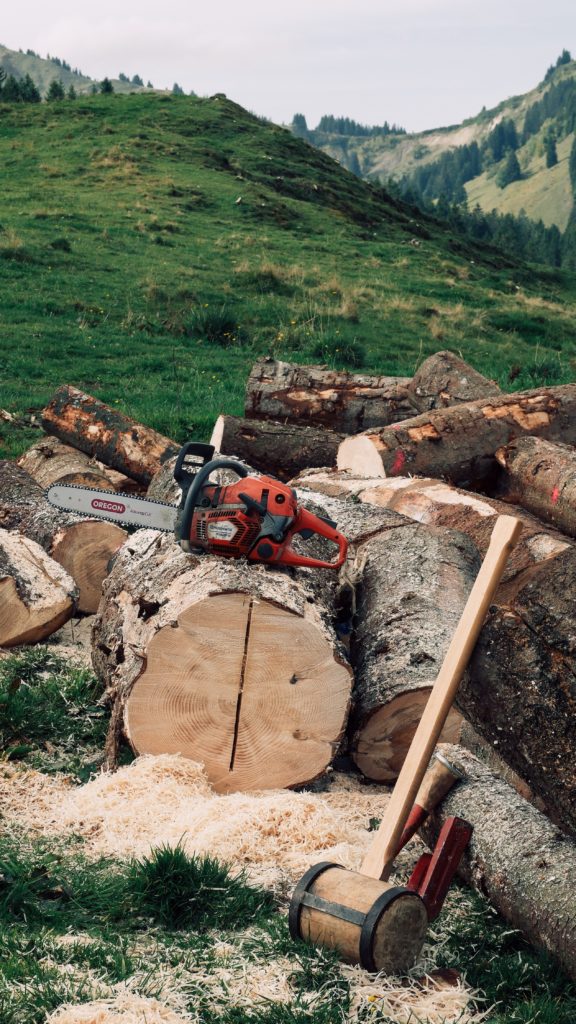
Sharp chainsaw chains are easier to work with, so it’s definitely worthwhile to have your chainsaw chain sharpened. Sharp blades on your chain will enable cleaner cuts through wood with less effort. And fortunately, chainsaw chains may be sharpened several times with no expense.
Keep in mind that on most chainsaws, the chain will stay sharp for about three hours of use. If you use your chainsaw all year long, mounting your sharpener will make it simple to maintain the tool and will also help you avoid mishaps. As a general rule, you should sharpen the chain after 10 uses. Depending on the material being cut and the chain being used, though, you may need to sharpen it after each cutting session.
Special files are used to sharpen chainsaw chains. Most other chainsaw users use circular files for sharpening, although some expert loggers use square files similar to those used to sharpen knives. Chainsaw files typically come in three sizes: 5/32″, 3/16″, and 7/32″.
To sharpen the chain:
- Engage the chain brake.
- Clamp the bar in a vise.
- Position the guide between the chain’s rivets (arrows should point in the direction of the bar’s nose).
- Follow the cutter’s top plate’s angle; the guide rollers will prevent you from getting too far into the side plate.
- On the file guide, mount a round file.
- Hold the file horizontally with the bar at a 30- or 35-degree angle, which means you’ll be holding it at a right angle vertically.
- For stability while sharpening, make a 2″-deep kerf in a log and place the saw bar within.
- Find a cutter on the top of the bar as well as toward the end and place the file and file guide in it.
- Use a pen to mark the top part of the cutter you chose.
- Align the file with the cutter’s ground angle.
- Make a stroke away from your body but parallel to the ground.
- Stroke each cutter five or six times.
- Use the file to file every other cutter.
- Repeat on the other side of the bar.
- Durable ➡ The latest, hardest titanium-coated diamond WHEEL we’ve ever made, owns a long lifetime. So you don't have to replace it often, 6 pcs [5/32''×2, 3/16'' ×2, 7/32'' ×2] of wheels are provided which can help sharpen any of the chains out there. Less but better.
- Easy to Use ➡ No chain removal required, No replacement parts needed, Only 4 installation steps are needed at the first time of usage, and an easy-to-follow VIDEO is provided. Let's simplify your sharpening work with this helpful Chain saw Sharpener.
- Fast Result ➡ This is a HIGH-POWER sharpening tool, which means that even sharpen the bluntest chain, you can see how quickly your sharpening work could be done just in a few minutes. And get rid of troublesome hand sharpening once and for all. This is a great replacement for hand chain saw file/ sharpener.
- Accuracy ➡ With the Angle Attachment' help, see how easily you can be a professional and sharpen chainsaw blade at an exact angle & depth, which can efficiently makes the chain razor-sharp & protects the chain from wrong-angle damage. Thus, getting you chain back to razor sharp is no longer a unique ability of hand files.
- Perfect Assistant ➡ This efficient chainsaw sharpener is the perfect companion for chainsaws. It sharpen the chain, protects the chain, makes work easier & safer than ever before. And the exquisite packaging makes it a unique and practical GIFT for father husband and logger. So, get it and you will find you are a cool working style leader!
What to Do If Your Chainsaw Is Not Cutting
When it comes to troubleshooting a chainsaw that won’t cut, you must first take into consideration the type of chainsaw. Is it electric or gas powered?
Electric Chainsaw Won’t Cut
There are multiple things that could cause this. They include:
- Fluctuations in power sources
- Motor issues
- Clogged unit
- Dead battery
- Broken chain
- Poor lubrication
Cordless electric chainsaws operate on batteries. As the battery runs out, though, the discharge rate decreases. If the battery is low, it should reduce the effectiveness of the electric chainsaw but not entirely shut it off.
If there are significant fluctuations in the power supply, corded electric chainsaws may stop operating. Much of the time, a low-quality or damaged extension cord is the primary cause of an electric chainsaw that won’t cut. You can check with the manufacturer of the chainsaw to determine what size and length of extension cord work best with the machinery.
In a variety of situations, electric chainsaws can become clogged. And because it is common for sawdust to clog a unit, you should always clean the chainsaw after each use. There’s also a chance that a foreign object could clog the unit, making proper care and maintenance of the chainsaw all the more important.
Gas Chainsaw Won’t Cut
If your gas-powered chainsaw won’t cut, there’s a good chance that one of the following issues is the cause:
- Engaged chain brake
- Incorrect tension on the chain
- Incorrect assembly of the guide bar
- Improper installation of the chain
- Dirty air filter
- Damaged drive assembly
- Damaged guide bar
If the chain brake is engaged, simply disengage it and see if the chainsaw will now cut. If it won’t, check the chain tension as it might be too tight. If it is, this is an easy fix. Simply locate the bar-retaining nuts and loosen them. To loosen the nuts, you’ll need to find the tensioning screw and rotate it counterclockwise. Once you have it in the position you want, tighten the nuts.
You’ll need to check the owner’s manual for your chainsaw to confirm that all parts are assembled and properly installed. The manual will show you how to assemble and install the guide bar, the chain itself, the drive assembly, and the cutters. If everything is properly installed, check the air filter to see if it’s dirty. If it is, change it or clean it.
Reasons to Oil a Dull Chainsaw Blade
Your chainsaw’s performance and durability depend on proper oiling. Although chainsaws have many moving parts, the bar and chain are the ones that require the most maintenance.
There’s a very good chance that you need to apply bar and chain oil right away if the chainsaw chain doesn’t move as quickly as it normally does. A chainsaw that runs out of gas quicker than normal is another sign that it probably needs chain oil.
There is continuous contact between the bar and the chain. Without oil, the chain’s rapid passage over the chainsaw bar may result in significant friction. And when there is a lot of friction between the bar and chain, this translates to a sluggish chain. It also requires the machinery to use more fuel than normal and can cause buildup that results in serious harm to your saw.
- ECO-FRIENDLY LUBRICANT: With ultimate biodegradability, our green, non toxic chainsaw oil is made from North American grown plant oils, so it’s safer for you, safer for your pets and safer for the environment than petroleum based products.
- HIGH PERFORMANCE: Our professional Pro100 Bar & Chain Oil has a high flash point up to 600°F and excellent temperature stability even in extreme conditions. The all season bio-based commercial quality lubricant has a minus 20°F pour point.
- PROFESSIONAL QUALITY: Safer for your employees and better for your equipment, our yard-safe supreme grade chainsaw oil offers outstanding lubricity, superior wear protection, and is high tack to reduce high speed oil sling.
- NON TOXIC FORMULA: Containing no petroleum base oils or metal-based additives, our eco-friendly lubricant is ideal for chainsaws as they are 100% loss applications. This green lube is suitable for use around waterways and other sensitive areas.
- MADE IN THE USA DEWALT Bar & Chain Oil is USDA Certified Bio-based Product
Should a Homeowner Use a Chainsaw?
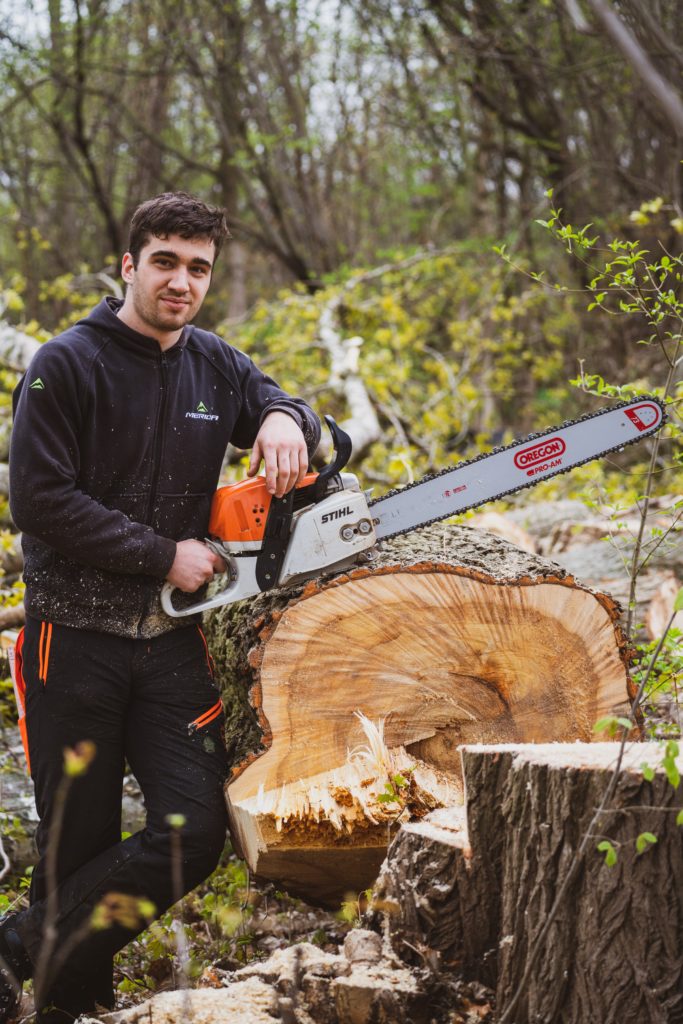
One of the main reasons that homeowners keep a chainsaw around the house is because it has such versatility. Chainsaws can help with many types of tasks around the house, including cutting firewood, pruning trees and gardens, building porches and decks, fencing, and more.
Another reason that homeowners like to keep a chainsaw around the house stems from its quick operation. Working with one can help you save a ton of time because of how fast they can cut. If you use a regular saw, it ends up taking a long time to cut through thick pieces of wood, while a chainsaw can likely finish the job in less than 60 seconds.
Additionally, compared to hand-cutting everything, operating a chainsaw will leave you feeling a lot less exhausted and worn out afterward. Naturally, as you use the chainsaw more and more, the chain will tarnish and the blade will become dull. This is why it’s so important to replace or repair the tool when you notice it’s not cutting like it normally does.
Is a Chainsaw Without a Chain Dangerous?
It’s not advisable to run a chainsaw without a chain. Make sure to just run it briefly if you need to power it on but not actually use it, such as when you need to fix the engine. Most of the time, you should leave it running for no longer than five minutes if it doesn’t have a chain on it. Why? Because the engine will rev more quickly without a chain.
If you examine a chainsaw, you will notice that the chain is attached to the sprocket and coiled around the bar. When using this type of machinery, the chain will circle the bar repeatedly. The bar does not actually cut anything; its only purpose is to help the chain move through its groove.
The engine will encounter far less resistance without the chain, and as a result, it will turn more often than usual, specifically when you accelerate. Without a chain, you also run the risk of revving the engine and putting extra strain on the centrifugal clutch.
Oil leakage is another possible annoyance when using a chainsaw without a chain. Usually, the chain collects the oil from the perforations in the bar and uses it to reduce friction. When using the saw with no chain, though, the oil will leak out of the bar’s oil holes when you push the throttle and will likely make a mess. This is why it’s highly recommended to empty the oil reservoir if you’re going to use a chainsaw without a chain.
Understanding Chainsaw Chains
Since multiple types of chainsaw chains exist, understanding how they work is key to using them and avoiding a dull chainsaw blade. An understanding of chainsaw chains also helps when sharpening chainsaw blades.
Link Pitch
The pitch of a chainsaw chain is determined by the length of separation between the chain’s drive links. All chains have a drive sprocket and a bar tip sprocket; the distance between the two must be the same as the distance between the links in the chain. Most times, a bigger pitch is normally a sign of a heavier, larger chain. As you shop for chainsaws, you’ll quickly notice the most common pitches are 0.325″ and 3/8″.
Metric Chain
The chain gauge measurement is determined by the part of the drive link that slides into the grooves found in the guide bar. When looking at a chain gauge measurement, keep in mind that the metric defines the drive links and their thickness. The thicker links will typically weigh more, but they are much stronger. With a lighter machine, you can achieve a much faster cutting speed. However, if the chain gauge and bar gauge are not the same, the fit will be improper, and you’ll end up damaging the chain and blade if you try to use the chainsaw. Typically, a chain with a larger pitch will have teeth that can cut through wood at a greater depth, and thus more power is required to successfully cut through the wood. The gauge sizes that are most common are 0.050″, 0.58″, and 0.63″.
Drive Links Count
Knowing the precise number of drive links in the chain is crucial. By knowing the exact number, you can better explore various types of chainsaws in different saw types and size categories. You need to know the precise number because chainsaw manuals and packages don’t always display this measurement. The overall length of chains is determined by a combination of the pitch and the number of links, so length measurements are not always relevant.
